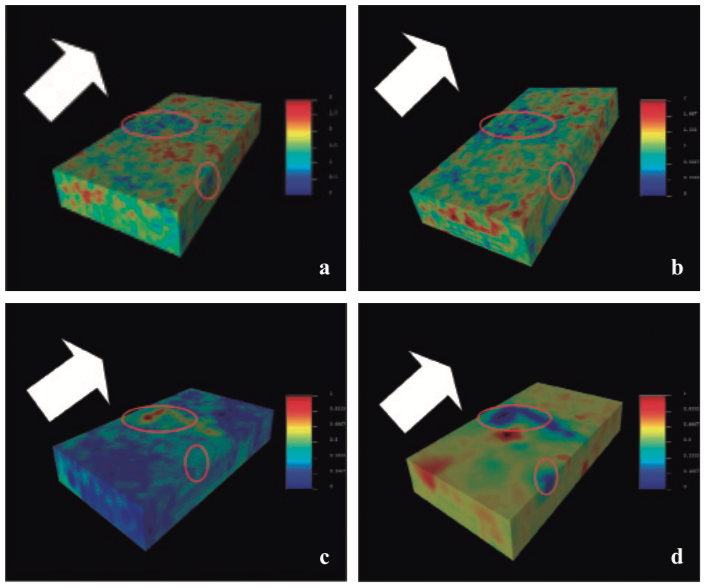Petrophysical characterization of oficina formation in a sector of the carabobo block by fractal methods

Published 2018-12-20
Keywords
- Fractal algorithm,
- models of petrophysical isoproperties wells register
How to Cite

This work is licensed under a Creative Commons Attribution 4.0 International License.
Abstract
The purpose is to generate models of petrophysical isoproperties from statistical methods that contribute to the static characterization of deposits, the concept of fractal which is defined as an object whose structure is repeated at different scales, was the applied method. Considering that the Carabobo field presents low angle, it was decided to use fractals in this investigation introducing as input records those of gamma rays, density, resistivity and effective porosity, to which the method was applied. for the elaboration and analysis of petrophysical isoproperties models, since they comply with the condition that the records behave as series in time, with randomness and can be normalized. From the analysis by the scaled range technique “R/S” (re- escalation), the Hurst exponent or coefficient (H) is obtained, which indicates the degree of rigor and persistence of the data with distance, establishing in this way the scope of the same when performing the fractal interpolation of the wells, thus generating pseudopozos. The spatial distribution of the petrophysical properties was estimated from the integration of the original wells and the generated pseudo-wells. Corroborating that it is a useful tool, it reduces the uncertainty in the determination and extension of prospects in exploratory processes and improves the visualization of the petrophysical properties both horizontally and vertically.
Downloads
References
Belmares, J (2011). Distribución especial de parámetros petrofísicos por modelación fractal en la caracterización estática de yacimientos. Trabajo Especial de Grado. Instituto Politécnico Nacional.
Busnego H. (2012). Generación de un modelo petrofísico y análisis de incertidumbre de las variables de roca y fluído, relacionadas con los parámetros de corte calibrados con información de núcleos pertenecientes al bloque 5, área petroindependencia, división Carabobo de la faja petrolífera del orinoco. Tesis Especial de Grado. Universidad Central de Venezuela, Caracas.
Calvo, Arturo. (2008). Possibilities to increase the Recovery Factor in Petromonagas area, Orinoco Heavy Oil Belt, Venezuela. Trabajo Especial de Grado, The Robert Gordon University, Aberdeen School of Engineering, pp. 6-17.
Chramcow, D. (2008). Interpretación Sismo- estratigráfico del área de Pichincha perteneciente a la Faja Petrolífera del Orinoco. Informe final de cursos en cooperación. Universidad Simón Bolívar, Caracas.
Crespo, J. (2008). Modelo sedimentológico- estratigráfico, bloque Carabobo 2, Faja Petrolífera del Orinoco. Trabajo especial de grado. Universidad Central de Venezuela.
Escobar, F. H., Cantillo, J. H., & Santos, N. S. (2011). A practical approach for estimation of the average reservoir pressure from multi-rate tests in long horizontal wells. Revista Fuentes, El Reventón Energético, 9(1).
Funkhouser, H.J., Sass, L.S y Hedberg (1948). Santa Ana, San Joaquin, Guario, and Santa Rosa oilfields (Anaco fields), central Anzoátegui, Venezuela. Am. Assoc. Petr. Geol. Bull., edición 32 (10). pp. 1851-1908.
Hedberg, H.D. (1950). Geology of the Eastern of Venezuela Basin (Anzoategui-Monagas-Sucre- Eastern Guarico portion). Am. Assoc. Petr. Geol. Bull., edición 48 (11). pp. 1755-1803.
Herrera, V. (2007). Simulación numérica de Paisajes montañosos, cuencas hidrográficas y procesos de lluvia, erosión y depositación. Trabajo Especial de Grado. Universidad Simón Bolívar, Sarteneja-Caracas.
Mandelbrot Benoit B. (1977). The Fractal Geometry of Nature. New York, USA: W.H Freeman and Company.
Mandelbrot and Van Ness. (1968). Fractional browian motion, fractional noise and application, SIAM Review, pp. 442-447.
Martín, C. A. G., García, R. E. P., Niño, J. C. L., & Lombana, H. B. (2014). Optimización de la metodología para el cálculo de porosidad a través de saturación de fluidos. Revista Fuentes, 12(2).
Meneses, A. F. O., Moreno, L. F. C., & Plata, J. A. R. (2017). Metodología experimental para la estimación de permeabilidades relativas en dos y tres fases por medio de ajuste histórico.
Revista Fuentes, 15(1), 75-85.
Meneses, A. F. O., Otero, E. H., & Santos, N. S. (2017). Estimación de saturaciones in-situ durante experimentos de inyección de fluidos usando tomografía computarizada de rayos X. Revista Fuentes, 15(2), 107-116.
Otero, E. H. H. (2016). Generación del modelo geoestadístico de los depósitos fluviales para la formación mugrosa del campo colorado. Revista Fuentes, 14(2), 29-39.
Pérez, R. (1994). Programa en Matlab para el cálculo del exponente de Hurst y dimensión fractal de series de tiempo. Recovered 15 of august of 2017, by http://www.geociencias.unam. mx/~bole/eboletin/progHurstyD1108.pdf
Remy Nicolas, Boucher Alexander and Wu Jianbing (2009). Geostatistics with SGemS. New York: Cambridge, University Press.
Velandia, J. L. P. (2013). Simulación numérica del flujo bifásico agua-petróleo en un medio poroso. Fuentes: El reventón energético, 11(2), 10.
Villar, A., Moreno, L. F. C., Hernandez, J. H. C., & Molina, J. J. R. (2017). Predicción del daño a la formación por acumulación de CaCO3 durante el flujo constante de salmueras en el medio poroso. Fuentes: El reventón energético, 15(1), 49-57.
Yoris, F., & Ostos, M. (1997). Geología de Venezuela: Geología general y cuencas petrolíferas. Texas: Jolley Printing.